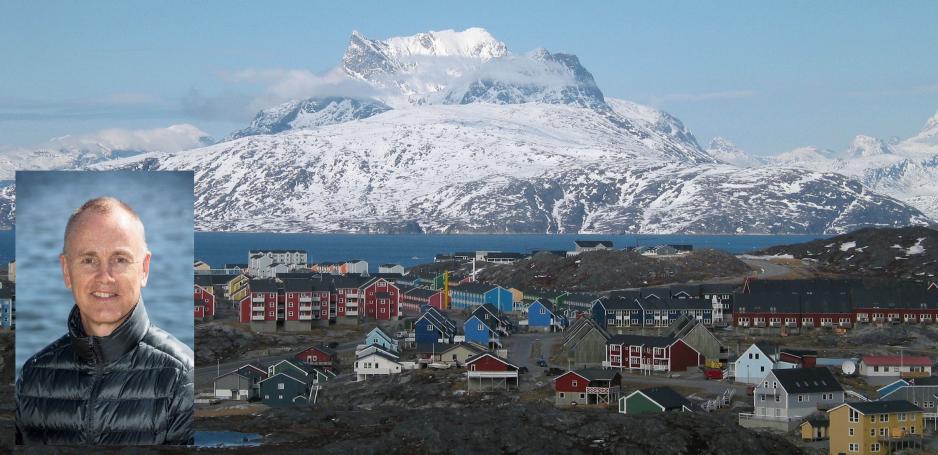
Last time I was in Narsaq, the diminutive sign was still testifying to the event: “Niels Bohr Square”.
While the sign was put up, Danish soldiers worked their geiger counters on Kuannersuit, a nearby mountain, where geologists had found extraordinary amounts of radioactivity.
The ambition was to bring uranium from Narsaq, which is, according to the 1350 local inhabitants, the most beautiful town in Greenland, to Denmark for use in yet-to-be developed nuclear power plants.
A mine shaft, the mouth of which can still be seen, was drilled halfway up the mountain, and in 1980 more than 4200 ton of ore was shipped to Denmark for closer scrutiny. Shortly after, Denmark decided never to build any nuclear power plants, and the importance of Greenland’s uranium paled to the same colour as Niels Bohrs.
Instead, the lead role was given to the so-called rare earths; the superminerals of our time.
The Kuannersuit mountain at Narsaq holds one of the largest known deposits of rare earths in the world. Rare earths, which contain 17 different minerals, are found in many places on Earth, but nowhere in as tempting amounts and compositions as in Narsaq, and the mine on the top of Kuannersuit, some 600 meters above sea level, has never been closer to becoming a reality than today.
Which is why the political process that was officially started on Friday may influence no less than the national defence of the US and its allies, technology needed for the fight against global warming and the future of Greenland.
Another mining project, Tanbreeze, which lies less than 50 kilometers away, also holds rare earths and is also edging closer to fruition, but Tanbreeze is smaller, has no uranium, and most political attention is presently on Kuannersuit.
Political support
After ten years of wrangling with Greenland Minerals A/S, the mining company behind the plans for Kuannersuit, Greenland’s environmental authorities have tentatively approved the company’s plans for environmental protection at the proposed mine and the plans for other interaction with the surrounding society.
This is an important mine.
Now that the relevant documents have been translated into Greenlandic, which is Greenland’s official language, the final political process has begun. For now, a majority in parliament has declared itself in favor of the mine, if no unexpected environmental problems are unearthed during the public hearings.
“This is an important mine. It will create jobs and economic growth. It would be great if we were already at the finishing line, but we must of course follow the law and the process must be allowed to be played out,” he told me in Nuuk a few days ago.
With the necessary reservations he predicts that the mine may open “within a year, perhaps only half a year”. This is epoch-making.
Indispensable minerals
If you look at Kuannersuit from the air, you will see large whitish patches of mountain with little or no vegetation. The rare earths are sufficiently potent to be easily detected, and while most people have no inkling as to their practical use, their importance to the world has grown almost as fast as that of uranium back when nuclear power was in the making.
Today, scores of crucial technological inventions are highly dependent on rare earth minerals. These minerals, with names like neodymium, praseodymium, terbium and dysprosium, are indispensable in the electronic fridges, self-driving cars and other electronics that are to communicate through the internet-of-things.
They pulsate in the computer, I write on, in my cell phone and in navigation systems for nuclear missiles. They are used in solar panels and they are essential in magnets for the pumps, windmills and electrical vehicles that are paramount for the fight against global warming.
Without the rare earths many of the political ambitions to combat the climate crisis would be endangered. According to Greenland Minerals Kuannersuit is particularly rich in four of the key minerals – the ones mentioned above.
In Nuuk during a two hour briefing, Jørn Skov, who is Greenland Minerals’ new Executive Managing Director, told me that Kuannersuit may satisfy towards one fifth of the world’s demand for these four:
“I think it is a fantastic story. Greenland can deliver 15-20 percent of what is needed to drive the green transition. This is the world’s greatest challenge, and imagine that Greenland can help solve this. Meanwhile, Kuannersuit may also solve some of Greenlands own fundamental economic problems,” he says.


